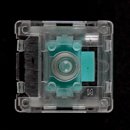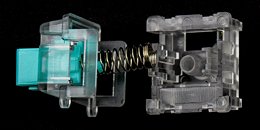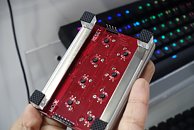- Joined
- Jul 1, 2014
- Messages
- 3,696 (0.97/day)
Readers of our website may be familiar with the Wooting brand for their then, and now, excellent Wooting One analog keyboard that we examined in late 2017. It impressed us enough to be the top keyboard for the year as well, and still remains one of the few keyboards to offer analog control at all, let alone on every single switch it is on. The company has since come out with a full-size Wooting Two, along with another switch option using a heavier spring. Their switches to date are linear optical switches manufactured by Flaretech to Wooting's design, and the company admitted there was not much more they could do with the current design. This brought us to Computex 2019, wherein they demonstrated their next generation switches for analog control, gave us some samples to take apart, and also showed off a neat prototype technology for the future- if it pans out, anyway.
The Hall effect has been used for keyboard switches in the past, as much as nearly four decades ago, no matter what some people may tell you when describing Steelseries' new switch from Computex also based off the Hall effect. Indeed, it had a small resurgence a couple of years ago in the enthusiast keyboard arena when "Ace Pad" and "XMIT" worked together for a Massdrop-exclusive keyboard, but 2019 does seem to be the year they come back in the public eye. Wooting's take is called the Lekker switch, a word in Dutch that can stand for different things depending on the context but generally stands for something impressive. Read past the break for more on the Lekker switch, as well as other things that might interest you.




The Lekker switch is manufactured not by Flaretech, but by Huano- a mice switch manufacturer based in China, who have since diversified their portfolio to include keyboard switches as well. The Hall effect sensor itself is an integrated part of the keyboard PCB, as with the optical sensor before, and these are made by Taiwan-based Major-Power (mPower) who have a lot of experience with Hall effect products already. The switch itself is linear, at least in its current iteration, with a turquoise-colored stem and a clear housing. The stem has walls around to help add in some dust and spill resistance, while still retaining Cherry MX stem keycap compatibility. There is also a small magnet in each switch, as expected, and you can read more here if you want to know more about the Hall effect as it pertains to these switches.





The Wooting Lekker switch is rated for as much as 100,000,000 clicks for life span, which they say is also just an estimate given they have not had a switch go bad in testing yet. Theoretically it would be the life span of the sensor on the PCB, or even any metal degradation of the spring itself, but there are inherent advantages in this route in terms of switch design and longevity. The spring itself helps provide a peak force of 65 cN, and the actuation force itself is of course dependent on the actuation distance and thus is not a single number here. The actuation range is rated for 0.1 to 3.8 mm, with a total travel distance of 4.0 mm. Wooting is giving themselves some luxury with a margin of error, but it is still better than any other analog switch to date as long as it works as rated.


Wooting showed off also a special Wooting Two Lekker edition keyboard, a limited edition unit using a custom PBT keycap set paired to a blue anodized aluminium case and the Lekker switches that will help fund the development of the switch and other things in the future.



In addition, Wooting also were happy to share the spotlight with a Dutch startup, Alltrons B.V., that aims to use inductive sensing as an alternative means to analog control on keyboards. The technology is still in its infancy, and you can read more here if interested. But it is interesting to note that we have gone from pressure sensing to analog control to the Hall effect, and possibly other technologies, all in the quest to make a keyboard truly worthy of the gaming moniker.
View at TechPowerUp Main Site
The Hall effect has been used for keyboard switches in the past, as much as nearly four decades ago, no matter what some people may tell you when describing Steelseries' new switch from Computex also based off the Hall effect. Indeed, it had a small resurgence a couple of years ago in the enthusiast keyboard arena when "Ace Pad" and "XMIT" worked together for a Massdrop-exclusive keyboard, but 2019 does seem to be the year they come back in the public eye. Wooting's take is called the Lekker switch, a word in Dutch that can stand for different things depending on the context but generally stands for something impressive. Read past the break for more on the Lekker switch, as well as other things that might interest you.




The Lekker switch is manufactured not by Flaretech, but by Huano- a mice switch manufacturer based in China, who have since diversified their portfolio to include keyboard switches as well. The Hall effect sensor itself is an integrated part of the keyboard PCB, as with the optical sensor before, and these are made by Taiwan-based Major-Power (mPower) who have a lot of experience with Hall effect products already. The switch itself is linear, at least in its current iteration, with a turquoise-colored stem and a clear housing. The stem has walls around to help add in some dust and spill resistance, while still retaining Cherry MX stem keycap compatibility. There is also a small magnet in each switch, as expected, and you can read more here if you want to know more about the Hall effect as it pertains to these switches.





The Wooting Lekker switch is rated for as much as 100,000,000 clicks for life span, which they say is also just an estimate given they have not had a switch go bad in testing yet. Theoretically it would be the life span of the sensor on the PCB, or even any metal degradation of the spring itself, but there are inherent advantages in this route in terms of switch design and longevity. The spring itself helps provide a peak force of 65 cN, and the actuation force itself is of course dependent on the actuation distance and thus is not a single number here. The actuation range is rated for 0.1 to 3.8 mm, with a total travel distance of 4.0 mm. Wooting is giving themselves some luxury with a margin of error, but it is still better than any other analog switch to date as long as it works as rated.


Wooting showed off also a special Wooting Two Lekker edition keyboard, a limited edition unit using a custom PBT keycap set paired to a blue anodized aluminium case and the Lekker switches that will help fund the development of the switch and other things in the future.



In addition, Wooting also were happy to share the spotlight with a Dutch startup, Alltrons B.V., that aims to use inductive sensing as an alternative means to analog control on keyboards. The technology is still in its infancy, and you can read more here if interested. But it is interesting to note that we have gone from pressure sensing to analog control to the Hall effect, and possibly other technologies, all in the quest to make a keyboard truly worthy of the gaming moniker.
View at TechPowerUp Main Site








